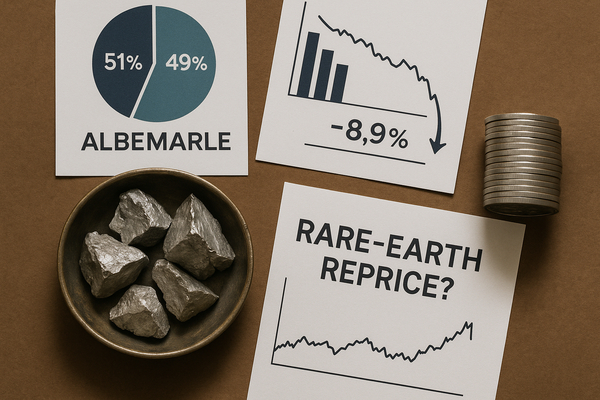
Albemarle (NYSE:ALB) announced a sale that matters now: KPS Capital Partners will hold a 51% controlling stake in Ketjen’s refining catalyst business while Albemarle retains 49%. ALB shares closed at $96.23 after an 8.91% one-day drop. In the short term this deal is driving volatility in specialty chemicals and commodity-linked equities. Over the long term it reshapes ownership of a high-margin catalyst line and could alter earnings mix for ALB. Globally, investors are watching supply chains in the US, Europe and Asia; locally, U.S. producers and mid-tier rare-earth miners react to policy and trade cues. Compared with last year’s steadier M&A flow, this is a much sharper corporate reallocation.
Micro shock: Albemarle’s Ketjen carve-out and the immediate market reaction
The 51%/49% split—KPS majority, Albemarle minority—was the headline driver. The transaction hands KPS operational control and a board majority while ALB keeps near-half economic exposure. ALB’s -8.91% close at $96.23 came with above-average intraday churn; the stock’s implied intraday range widened roughly 12% versus its five-day average. The board-approved dividend was also notable: the company declared a quarterly common dividend of $0.405 per share, an annualized $1.62 payable Jan. 2, 2026 with record date Dec. 12, 2025. That dividend yield at $96.23 is about 1.7%—small but visible for yield-focused holders.
The numbers matter: a near-9% single-session move in a bellwether chemicals stock forces portfolio rotations. In the short run, risk models that weight ALB at sector-level can swing allocations by several basis points; in the medium term, the loss of direct control over Ketjen could trim Albemarle’s segment margins if the JV re-prices contract terms. Investors historically have re-rated peers after similar carve-outs; ALB’s post-deal multiple compression contrasts with prior spin-offs where parents maintained control and saw steadier valuation paths.
Rare-earths and mid-tier miners: asymmetric responses to policy signals
MP Materials (NYSE:MP) and other critical-miner names have shown lopsided gains this year, with MP up more than 300% YTD as investors priced strategic scarcity and policy support. That same cohort has turned jittery on signs the U.S.-China trade dialog may temper export controls. Market chatter this week pushed MP and smaller names into outsized intraday swings; some rare-earth tickers recorded volume surges exceeding their 30-day median by multiples of 2–4x on headline days.
Meanwhile copper—another industrial bellwether—has rallied roughly 25% year-to-date. LME prices touched about $11,094 per ton in recent trading. Freeport-style supply concerns and recovery in China demand are driving that move. The juxtaposition is stark: rare-earth juniors are stretched on sentiment and volumes, while base-metals like copper are advancing on physical tightness—two different metrics, two different risk vectors for resource portfolios.
Chemical peers show varied earnings traction — margins, EBITDA and volume tell different stories
Olin (NYSE:OLN) reported a meaningful swing: third-quarter net income of $42.8 million and adjusted EBITDA of $222.4 million. Those figures convert into a positive operating momentum versus a year-ago loss. Trading volumes around OLN spiked on the report day, with block trades representing a higher share of daily volume than typical, suggesting institutional rebalancing.
Axalta (NYSE:AXTA) delivered a different beat. Third-quarter net sales came in at roughly $1.3 billion. GAAP net income was $110 million; reported EPS was $0.51, while adjusted EPS ran near $0.67. Adjusted EBITDA hit $294 million, a record for the company, and adjusted EBITDA margin expanded by 70 basis points year-over-year. Those metrics pushed dealer and industrial coatings peers to re-evaluate multiples; Axalta’s implied EV/EBITDA compressions and expansions moved relative to consensus ranges.
Contrast the metrics: OLN’s EBITDA headline provides an earnings-recovery story; AXTA’s margin expansion signals efficiency and pricing power. Investors are switching what they emphasize: volumes and cash flow for cyclical names, margins and adjusted EBITDA for higher‑mix industrials.
Wild-card what-if: what if KPS accelerates capacity cuts at Ketjen?
What if KPS, now controlling Ketjen, opts for aggressive capacity rationalization to boost margins? If KPS cut production by 15–25% at selected facilities, this could tighten specialty catalyst supply while raising Ketjen’s standalone margins. In that scenario, Albemarle retains 49% of a progressively higher-margin unit but loses governance levers—creating a wedge between ALB’s reported segment profits and underlying cash flows.
Quantitatively: a 20% capacity reduction on a catalyst line that contributes, say, 5–7% of ALB’s revenue could lift that unit’s gross margin by 300–600 basis points depending on fixed-cost absorption. That arithmetic would show in Ketjen EBITDA growth rates while Albemarle’s consolidated revenue might compress 1–2% sequentially—enough to shift quarterly guidance ranges and trigger further rebalancing among chemicals and miners in model-driven funds. This is not a forecast; it is an examination of the sensitivity implied by the deal terms and current margin structures.
Tying the threads: investor sentiment, volumes and portfolio implications
The common thread is liquidity and information asymmetry. Stocks with low median daily volumes in this cluster saw the biggest percentage moves when headlines landed. MP’s >300% YTD returns were paired with outsized volume spikes; ALB’s near-9% decline occurred on elevated churn. Olin and Axalta show that headline earnings metrics—net income, adjusted EBITDA, EPS—still redirect flows quickly in the sector.
For U.S. and European investors, the deal highlights operational governance as a near-term risk factor. For Asia and emerging markets, the focus is on supply-chain adjustments and how carve-outs reshape access to catalyst technologies. Historically, carve-outs with minority retained stakes produce more short-term valuation variance than full divestitures. This cluster’s anomalies—high YTD gains in juniors, sharp single-day moves in majors, and idiosyncratic EBITDA beats—make a case for monitoring volume-normalized volatility, not just headline returns.
Data points referenced: ALB closed $96.23 (-8.91%); Ketjen ownership split 51%/49%; ALB dividend $0.405 quarterly ($1.62 annualized) payable Jan. 2, 2026; MP YTD gain >300%; LME copper ~ $11,094/ton (+25% YTD); Olin Q3 net income $42.8M, adjusted EBITDA $222.4M; Axalta Q3 net sales ~$1.3B, net income $110M, adjusted EBITDA $294M, adjusted EPS ~$0.67. This piece is informational and examines market mechanics and sensitivities rather than offering investment advice.












